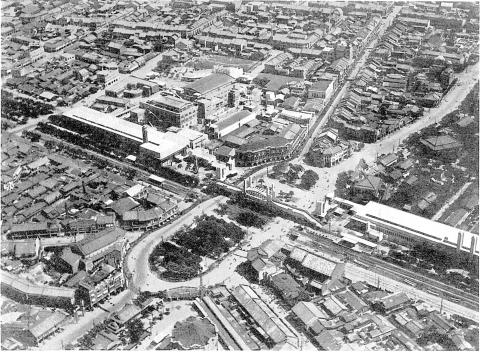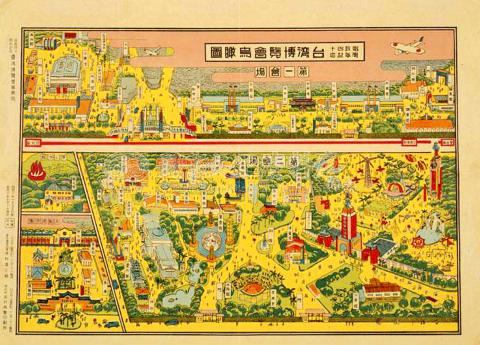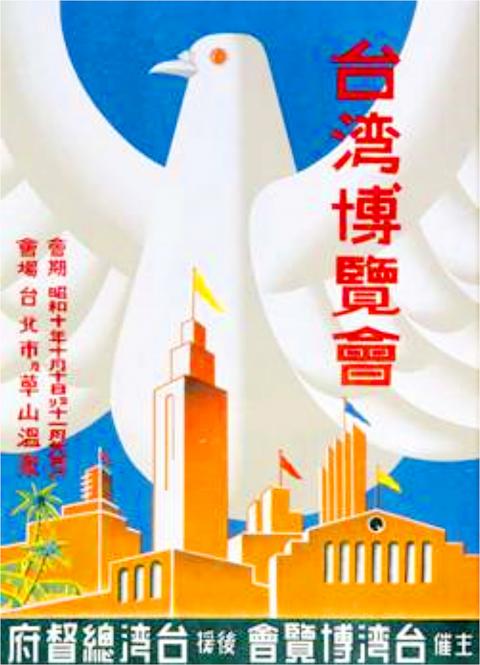Taiwan in Time: Oct. 10 to Oct. 16
On the morning of Oct.10, 1935, after the firing of three gun salutes, 1,500 doves were released into the Taihoku (today’s Taipei) sky as a band played Taiwan Leaping Forward, a Japanese song written especially for the occasion.
For the next 50 days, the entire country would be abuzz with activity as the extravagant and ambitious Taiwan Exhibition held to celebrate 40 years of Japanese rule took place not only in its main Taihoku venues, but with secondary exhibits in numerous cities such as Kirun (Keelung), Takao (Kaohsiung) and Karen (Hualien).

Photo courtesy of Wikimedia Commons
The main exhibition space of more than 130,000m2 was spread across 40 exhibition halls in Taihoku, showcasing more than 300,000 items including the products, industries and latest technologies of Japan, as well as Taiwan and its other colonies, and military, transportation and cultural displays.
The goal was not only for the Japanese to showcase to the world the accomplishments of 40 years of colonization, but it was also a display of might, as they intended to use Taiwan as a springboard for their military “southward expansion” plan (it’s not a coincidence that the exhibition included a whole section devoted to South China and Southeast Asia). Less than a year later, the colonial government began its Japanization program of the Taiwanese people to make them an even more integral part of the empire.
CHEN YI VISITS TAIWAN

Photo courtesy of Wikimedia Commons
The Japanese government invited officials from around the world to attend. One of them was Fujian Province governor Chen Yi (陳儀) — whose name would later be forever etched into Taiwanese history as the governor under whose rule (or misrule) the 228 Incident took place.
Chen enjoyed close ties with Japan as he had lived there for several years as a student and married a Japanese woman, and he had reportedly been tasked by Chinese Nationalist Party (KMT) leader Chiang Kai-shek (蔣介石) to maintain a friendly relationship with Japan. Chen had already sent an observation team to Taiwan in 1934 to use it as a case study of how to bring Fujian out of poverty, noting in a report that despite being much smaller in land area, Taiwan’s production was about six times that of Fujian’s.
On Oct. 21, 1935, Chen became the highest-ranking Chinese official to visit Taiwan during Japanese rule, staying for seven days as he visited the exposition and took a tour showcasing important colonial construction projects. He also met with Taiwan’s governor-general Nakagawa Kenzo and reached an agreement to cooperate economically. In 1936, Chen sent yet another observation team to Taiwan, filing a detailed report to Chiang.

Photo courtesy of Wikimedia Commons
Fo Guang University professor Chen Hsin-yuan (陳信元) writes in his study Chen Yi, Hsu Shou-shang and the Taiwan Provincial Editorial and Translation Bureau (陳儀, 許壽裳 與台灣省編譯館) that to save the Chinese officials face, exhibition staff removed signs mentioning “40 years of colonial rule” when they visited the exhibition. This mutual goodwill did not last long, as Japan would launch a full-scale invasion of China less than two years later.
The real consequence here is that this experience undoubtedly made Chen the prime candidate for governor-general of Taiwan after Japanese defeat, as he was “one of the very few important KMT figures after World War II who had any Taiwan experience,” writes Cheng Chia-hui (程佳慧) in her book The First Major Exposition in Taiwan’s History (台灣史上第一大博覽會).
GARGANTUAN EFFORT
The Japanese put a great amount of effort into this event. In addition to the aggressive promotion and number of people on the planning team, Cheng writes that they set up 46,999 temporary lights in Taihoku — making it the brightest city in Taiwan.
To involve the public, a contest was held for a theme song for the exposition — the top two winning songs were even pressed into records and widely played. Children were encouraged to submit essays about the event which they would read on public radio, and planes dropped about 600,000 fliers over various cities with free tickets and other promotions.
Other more sustainable changes were made, such as a concerted effort to prevent and eradicate typhoid fever and meningitis, which had ravaged the colony earlier that year. The government also improved air, sea and land transportation, and took the opportunity to promote tourism, renovating many historical sites and improving facilities.
Undoubtedly, some Taiwanese denounced the event — in Chu Tien-jen’s (朱點人) short story Autumn Letter (秋信), protagonist Dou Wen (斗文) laments: “The ‘Great Leap Forward of Taiwan’s Productivity’ indeed. Only you Japanese devils can leap forward. I’m afraid Taiwan’s youth don’t even have a chance to inch forward.”
But on the other hand, many local elites and businessmen worked with the Japanese to realize the event. Cheng writes that there were 6,506 Taiwanese members on the roster of the civilian Taiwan Exhibition Support and Sponsor Association (台灣博覽會協贊會). She also estimates that partially due to heavy propaganda and urging by the government, almost half of the Taiwanese population visited the exhibition in Taihoku.
Although Cheng writes that the exposition was “a product of Japanese imperial ambition,” it was also a microcosm of Taiwanese society in the 1930s. There have only been two comparable events in Taiwan’s history — the 1948 Taiwan Province Expo and the 2010 Taipei International Flora Expo.
Taiwan in Time, a column about Taiwan’s history that is published every Sunday, spotlights important or interesting events around the nation that have anniversaries this week.

Exceptions to the rule are sometimes revealing. For a brief few years, there was an emerging ideological split between the Democratic Progressive Party (DPP) and Chinese Nationalist Party (KMT) that appeared to be pushing the DPP in a direction that would be considered more liberal, and the KMT more conservative. In the previous column, “The KMT-DPP’s bureaucrat-led developmental state” (Dec. 11, page 12), we examined how Taiwan’s democratic system developed, and how both the two main parties largely accepted a similar consensus on how Taiwan should be run domestically and did not split along the left-right lines more familiar in

This month the government ordered a one-year block of Xiaohongshu (小紅書) or Rednote, a Chinese social media platform with more than 3 million users in Taiwan. The government pointed to widespread fraud activity on the platform, along with cybersecurity failures. Officials said that they had reached out to the company and asked it to change. However, they received no response. The pro-China parties, the Chinese Nationalist Party (KMT) and Taiwan People’s Party (TPP), immediately swung into action, denouncing the ban as an attack on free speech. This “free speech” claim was then echoed by the People’s Republic of China (PRC),

As I finally slid into the warm embrace of the hot, clifftop pool, it was a serene moment of reflection. The sound of the river reflected off the cave walls, the white of our camping lights reflected off the dark, shimmering surface of the water, and I reflected on how fortunate I was to be here. After all, the beautiful walk through narrow canyons that had brought us here had been inaccessible for five years — and will be again soon. The day had started at the Huisun Forest Area (惠蓀林場), at the end of Nantou County Route 80, north and east

Specialty sandwiches loaded with the contents of an entire charcuterie board, overflowing with sauces, creams and all manner of creative add-ons, is perhaps one of the biggest global food trends of this year. From London to New York, lines form down the block for mortadella, burrata, pistachio and more stuffed between slices of fresh sourdough, rye or focaccia. To try the trend in Taipei, Munchies Mafia is for sure the spot — could this be the best sandwich in town? Carlos from Spain and Sergio from Mexico opened this spot just seven months ago. The two met working in the